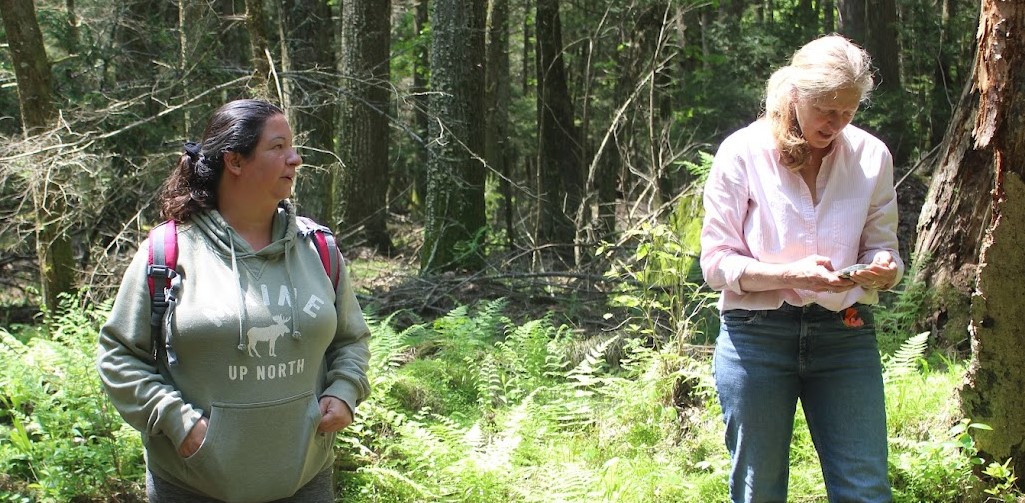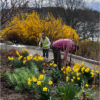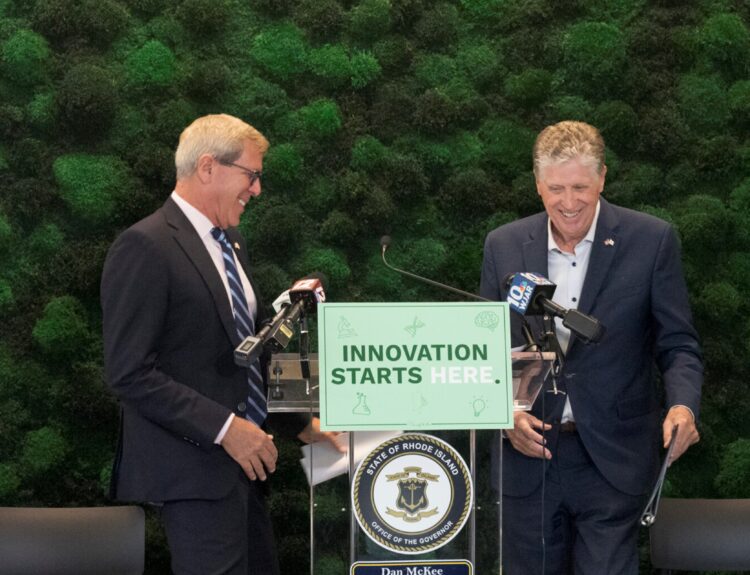‘If I want these areas that are very sensitive protected, nobody else is going to do it’
Originally published by ecoRI News, a nonprofit newsroom covering environmental news in Rhode Island. Read more at ecoRI.org
BURRILLVILLE — Tromping through the woods, Roberta Lacey and Samantha Young’s footsteps start to sound squishier and squishier the deeper they march into the forest and the closer they get to an undisclosed river.
There isn’t much of a trail, and it would be easy to get lost, but the two townies know the area well and are more likely to lose track of time because they’re following a colorful tree frog or a prehistoric-looking dragonfly.
Although Lacey still peeks under all the logs along the way, and Young tries to identify most of the fungi she sees, they are trying to stay focused. They have a turtle to find.
Lacey and Young asked that ecoRI News withhold the exact location of their walk because they know it’s home to a rare wood turtle. Young spotted one in the area this spring.
The wood turtle was once common in eastern habitats that included streams, fields, and forests. Because it lives both on land and in water, the wood turtle is vulnerable to loss of both types of habitat. Unlike others of their species, wood turtles don’t reach sexual maturity between 12 and 20 years old. They like to sit in sunny spots on riverbanks and try to blend in, rather than fleeing from predators, making them relatively easy to catch. Due to population decline, the turtles are under consideration for listing under the federal Endangered Species Act, according to the U.S. Fish & Wildlife Service.
Lacey and Young don’t want someone to go looking for what might be the only young wood turtle in the area, to take it home as a pet or sell it on the black market.
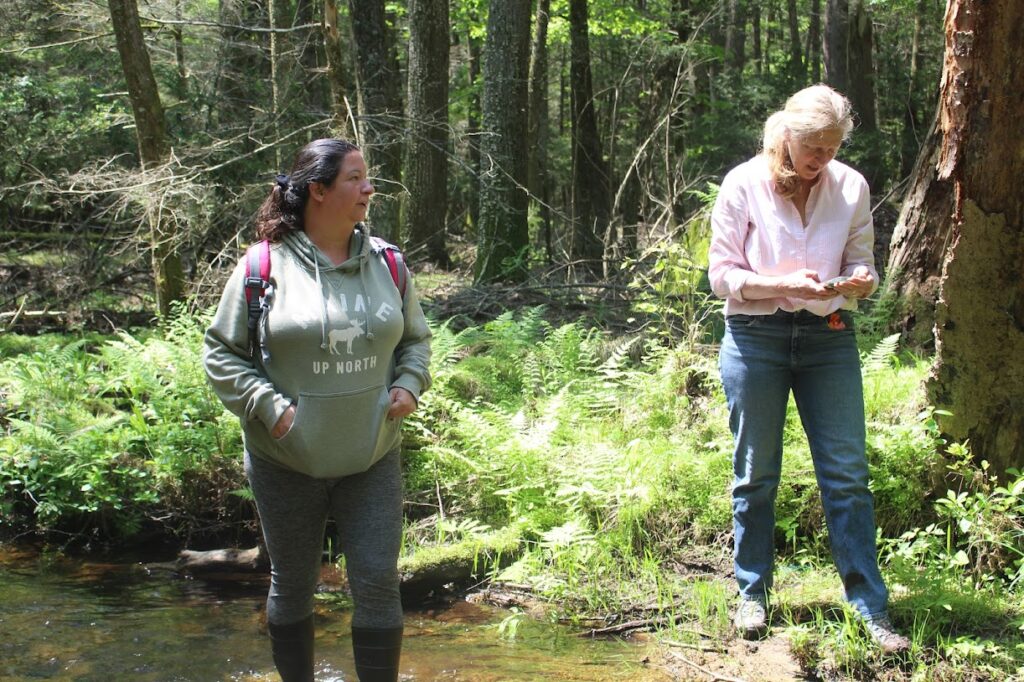
The pair, who grew up exploring the natural wonders of rural Burrillville, have long loved searching in the woods for wildlife. But recently their walks have taken on new meaning: Young and Lacey are trying to catalog the rare species that call Burrillville home, especially the rare turtles.
As members of the town’s Conservation Commission, they want to turn their efforts into natural heritage maps and perhaps even a municipal wildlife action plan that would encourage smart development in a town that is one of the last rural stretches in an otherwise densely populated state.
By the time Young and Lacey reach the water, Young says the turtle will likely hide in the moss and logs along the sunny sides of the river.
“It was actually sitting on a stick, which is unusual, usually you see them right on the edge,” says Young, recalling the small turtle she’d seen the week before. “I don’t know if it’s just because he’s a little baby and he’s testing the waters, though.”
Young gets into the river with her wellies, and crosses over to the other side, taking one bank while Lacey scours the other.
The pair bend over the slippery, muddy banks of the river, making their way upstream, hollering over to each other when they find something interesting: beaver-logged trees, orchids, butterflies — but no turtles.
A ways into the woods, Lacey thinks she’s spotted something shiny in the mud that could be a shell.
“My eyes aren’t what they used to be,” she cautions.
The shiny spot turns out to be late-season salamander larvae, not what the women are looking for today, but something that excites them no less.
“They’re so close to hatching that they have their tails and every … Oh! There’s a baby,” says Lacey, peering into the gelatinous larvae mound in her hand.
Although the walk into the “fairyland” of the forest, as Lacey calls it, is something they both enjoy, they’ve been taking notes and sending in identifications for the interesting creatures they find.
“We’ve been trying to target all the different areas around here that may have [wood turtles], so that we can document them and try and preserve that habitat before it’s gone,” says Young, in between picking up glistening dragonfly wings that she spots sparkling in the mud.
In addition to the turtles, they’ve been keeping their eyes on other species, getting an inventory of what’s in the forest for conservation mapping and, down the line, a wildlife action plan that would set priorities for how they want to protect species in Burrillville.
The plan wouldn’t stop development or even limit it, but “strike in some kind of balance” between what humans create and the habitat the wildlife needs, Lacey says.
She sees solutions like asking developers for bigger buffers when they’re building near sensitive areas or even just educating them about what’s near their property, in the hopes they’ll try to employ practices that will be less likely to tamper with wildlife.
“I don’t think we could ever hope for not doing development around here,” Lacey adds, “but I think that we could have an opinion.”
Lacey, Young, and the other members of the Conservation Commission have been working with the Rhode Island Natural History Survey’s Amanda Freitas on their maps and potential plan.
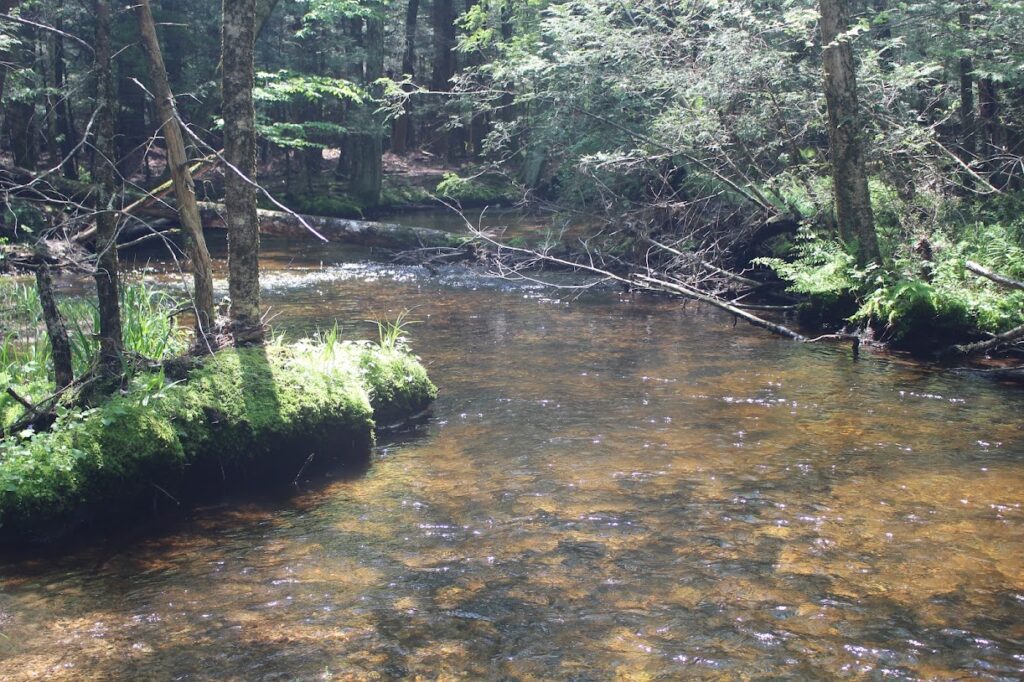
Freitas is the liaison to the Rhode Island Department of Environmental Management’s Wildlife Action Plan, a program that promotes wildlife protection throughout the state. She originally started working with Burrillville a few years ago, advising the town on how it could include wildlife protections for rare species in its comprehensive plan, which she says, “Burrillville did a really great job with.”
The comprehensive plan makes mention of the importance of providing movement for wildlife and conserving forest for habitat, for example. It also set, as a potential action item, the creation of conservation overlay zones based on where the rarest species are located.
Now, Freitas says, Burrillville is taking steps to set more clear conservation priorities. If the town completes its own wildlife action plan, Freitas believes they’ll be the first municipality to do so in the state.
“We’re all just kind of like, frankly, feeling our way through,” she says, in exploring how a wildlife conservation plan, or even just making town natural heritage maps, could work.
The plan itself wouldn’t be a law or regulation, it would be guidelines and priority setting, according to Freitas.
Even on the state level, a wildlife action plan doesn’t set regulation so much as it clarifies concerns.
Having a wildlife action plan on the state level allows Rhode Island to access a certain amount of federal money for conservation of otherwise unfunded species, including reptiles and amphibians. Even though there is funding, it isn’t much.
“The [state wildlife action] plan will shortly be revised, but in 2016 there were, I think, 454 species and the pie is usually around a half a million,” Freitas says. When that money then gets split between funding land conservation, research, and salaries for those overseeing both among many different animals, “That’s not a big pot.”
In this sense, “nothing I do is regulatory,” she adds, “so it’s really about, you know, where are their shared priorities and trying to work together to get conservation on the ground.”
Even in a town like Burrillville, where, Freitas says, “they care deeply and they’re pretty darn proactive, it’s still not an easy nut to crack.”
“Everything is already slated to be private property and developed,” she adds, “and you need resources to have a different outcome where things are conserved.”
Burrillville is “really trying to get it right before it — before they’ve lost too much,” Freitas says, “while they still have a lot of wildland, or natural land at least.”
Both Lacey and Young say the lack of funding makes the work they are doing frustrating, but they still feel it’s necessary.
“If I want these areas that are very sensitive protected, nobody else is going to do it,” Lacey says.

